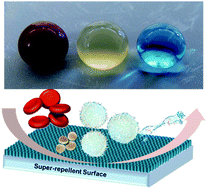Hemocompatibility of super-repellent surfaces: current and future†
Abstract
Virtually all blood-contacting medical implants and devices initiate immunological events in the form of thrombosis and inflammation. Typically, patients receiving such implants are also given large doses of anticoagulants, which pose a high risk and a high cost to the patient. Thus, the design and development of surfaces with improved hemocompatibility and reduced dependence on anticoagulation treatments is paramount for the success of blood-contacting medical implants and devices. In the past decade, the hemocompatibility of super-repellent surfaces (i.e., surfaces that are extremely repellent to liquids) has been extensively investigated because such surfaces greatly reduce the blood–material contact area, which in turn reduces the area available for protein adsorption and blood cell or platelet adhesion, thereby offering the potential for improved hemocompatibility. In this review, we critically examine the progress made in characterizing the hemocompatibility of super-repellent surfaces, identify the unresolved challenges and highlight the opportunities for future research on developing medical implants and devices with super-repellent surfaces.



 Please wait while we load your content...
Please wait while we load your content...
